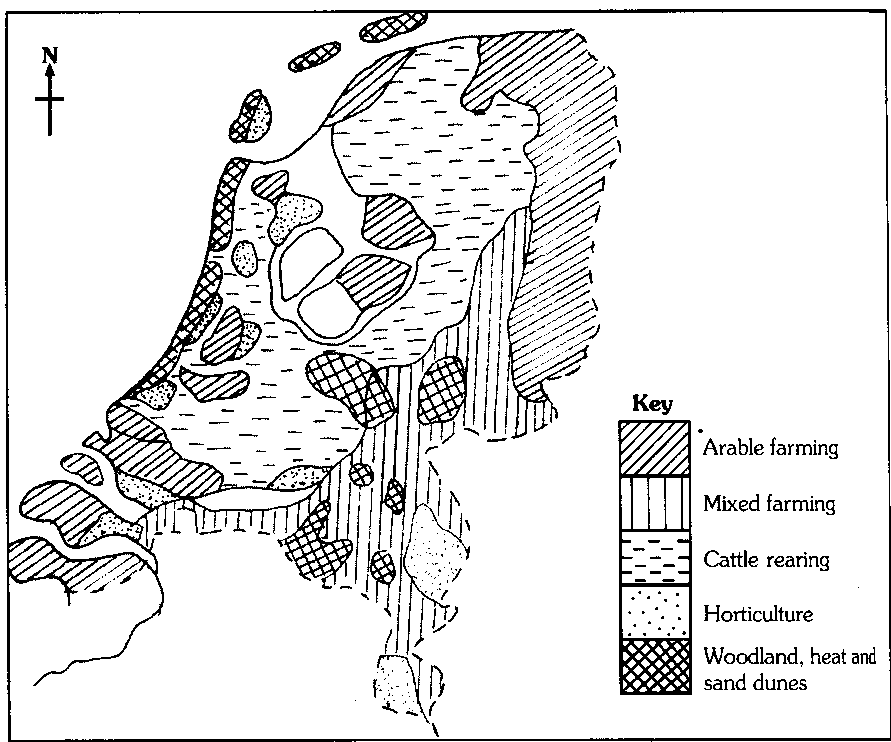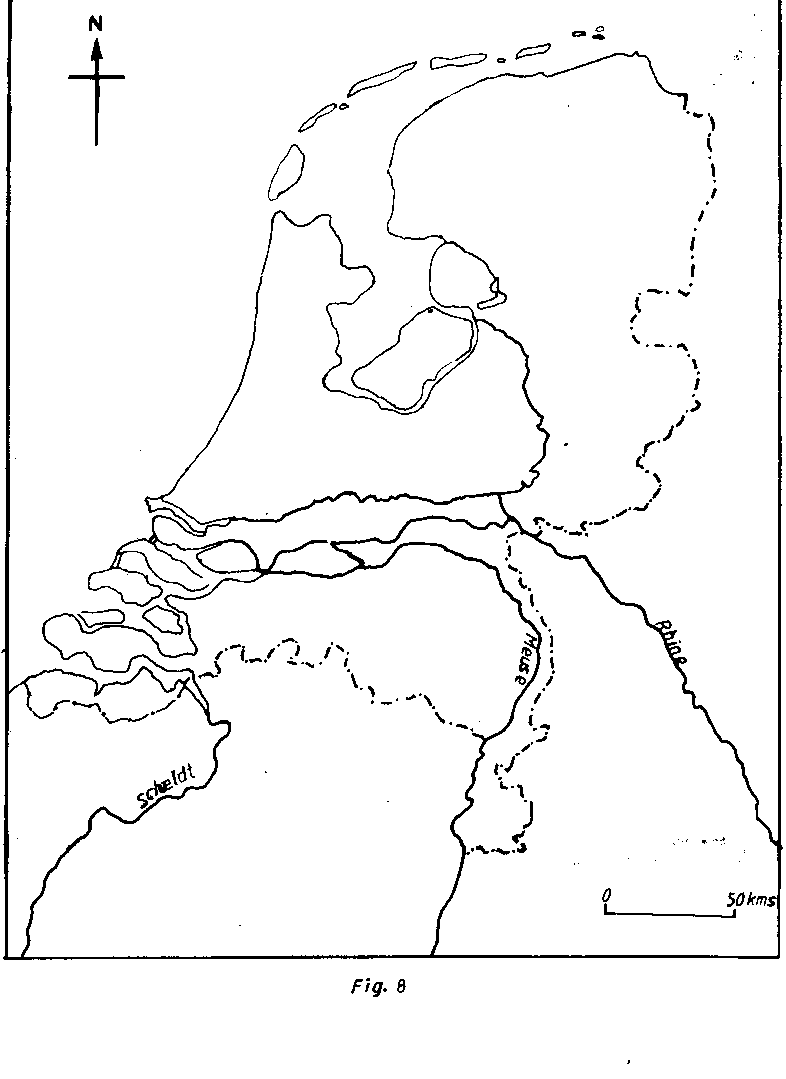Farming in the Netherlands
Factors favouring farming
It has got a mild climate as a result of the North sea influence of the warm Westerly winds which regulate her temperatures. This contributes much to the rearing of livestock - Dairy cattle plus sheep.
Precipitation (rain and snow) plays an important part in the arable farming for it favours the growing of temperate crops, wheat, Rye, Barley, potatoes among others
A variety of fairly fertile soils ranging from peat, clay to marine clay alluvial soils have contributed to a wide range of land use patterns in line with arable farming.
A well controlled water supply. The numerous canals and rivers as well as ground and rain water create abundant water for irrigation during drought. It is kept and controlled in reservoirs by use of pumping stations. Hence water is cheap in Netherlands.
Cheap water transport on both Rotterdam waterway and along the Western Scheldt water route makes the marketing of goods easy.
Map of Netherlands Showing Farming Types

The Dutch are active and well trained in agriculture and in mixed intensive farming modern methods through the organisation of cooperative societies.
The unique Geographical position of Netherlands at the proximity of the North sea and being the Gateway to European countries creates for her a favorable trading position as it has easy access to her neighbouring countries namely Britain, Germany, France, Belgium, Switzerland among others This also helps to have an effective marketing system for her products and so compete favorably well in both Agriculture and industry.
The neighbouring industrial countries namely Britain, Germany, Belgium provided a ready market foe exports especially fresh vegetables, fruits. Butter, cheese, eggs among others.

Scientific methods have been applied on the poor soils in the Eastern parts of the country by the use of fertilizers, humus to increase fertility and crop production.
Holland displays the example of intensive farming in the World with 77% of the area being dedicated to farming, 46% of which is to Grassland, 26% to arable and 5% to Horticulture.
Live Stock Farming
Dairying
This is the most important farming activity in Holland with 1/3 of the products for export. Dairying is a characteristic of the Grasslands in the heavy clay soils of the Polders and of the drained soils of the marshy lands. Over 3 ½ million acres of land are under grass.
There are over 4 million heads of cattle, dominated by the black and white Friesian breed which forms ¾ of the total figure.
The total milk production in Netherlands is approximately 7.5 million tons of which 7 tons are supplied to Dairy factories and standardization plants. Liquid milk consumption amounts to approximately 1.5 million tons per annum.

The Butter production amounts to 100,000 tons annually of which 50,000 tons are for export. It is the leading producer and one of the chief cheese exporting countries in the world.
Netherlands is also the biggest condensed milk exporting country in the world, with annual export of 325,000 tons. Netherlands produces 50,000 tons of milk powder most of which is for export. The dairying industry in Netherlands has trapped a lot of foreign exchange for the Dutch people.

Piggery
Pig farming is another industry, which has increased in order of importance. It is practiced in the sandy areas of Overjssel, Geulderland and North Brabant. They are reared for bacon and pork.
Poultry
This is also important and over 30 million birds are kept throughout Netherlands. The emphasis is egg production for export.
ARABLE FARMING:
Cereals
Use 60% of all the arable land. The Rye and 2/3 of the oats are grown on mixed farms in the South and East of the country.
Wheat and Barley are grown mainly on the clay soils or; the North and West with the exception of wheat, over 60% of the other cereals is used for stock - fed.

Oats, barley, and some products made from
cereal
Potatoes
They are grown all over the country. Out of the 130,000 hectares used for growing potatoes each year, one-third is devoted to industrial potatoes, i.e. by the starch mills are grown mainly on the reclaimed peat soils in the Fen District, North and North - East of the country, were a flourishing starch manufacturing industry has developed.
Potatoes grown for human consumption and stock feed amount to approximately 2.5 million tons. One million tons is used for human consumption. Large quantities are exported and over 250,000 tons are exported as seed potatoes.
Sugar beet
The area put under cultivation of sugar beet is approximately 90,00 hectares. About 60% of the total sugar beet crop is processed at the cooperative factories. There are 12 sugar beet factories. The largest factory produces approximately 1,000 tons daily of refined sugar.
In recent years, the sugar production has exceeded home requirements. Therefore, the surplus is for export. Besides sugar, the crushed vegetable matter is made into cattle cake, whereas the leaves serve as silage live stock feed.
Horticulture:
This is divided into branches: these are
- Vegetable growing,
- Fruit growing,
- Bulb growing,
- Floriculture (Flowers),
- Seed production,
- Cultivation of medicinal and aromatic herbs.
The geographical position of the Netherlands situated, as it is in the densely populated areas with excellent communication lines has attracted many consumers, the result of which has promoted the cultivation of vegetables and flowers under glass thatched houses under scientific means:
The increase in production of horticultural crops under glass scientific methods has been greater in Holland than in any other country in the world.
The export of the three important vegetables grown under glass are: tomatoes, carrots, cucumbers and lettuce plus beans, which have increased six fold in a period of fifteen years from N. Bradan, Breeba and Limburg.
The total area under vegetables including early potatoes and onions is over 58,000 ha. The annual production of fresh vegetables in the Netherlands has increased twice as much because of the considerable purchasing power among the working classes offered by first world countries. Actually more than 50% of the vegetables are for export.
The most important region for vegetable growing is in south - Holland with three important centres Rotterdam, Hague and Kring.
Another line of Horticulture specially in Netherlands is floriculture. This involves the growing of Tulips and Bulbs on the glass thatched house under artificial facilitates in South Holland, 85,000 tons are exported annually.
The flowers are in great demand for decorating houses, offices, hospitals, churches and for celebrating important occasions. Netherlands has 90,000 hectares used for growing flowers, concentrated chiefly around Aalsmer district. Roses, Idles, flowers are grown at Amsterdam where there is an important market for flowers at the port.

Wheat harvesting using combine harvester

Fruit growing
These are domination in Geulderland, Limburg and Utrecht where Apples pears , plums and cherries are looked after,
The Role and Importance of Cooperative Societies in Netherlands
The main purpose of setting - up cooperatives in Netherlands was to restore some bargaining power to the small producers.
The agriculture cooperative .were set up to provide a central selling outlet, whereby the societies sell produce on behalf of its members namely: fruits, vegetables, eggs, pigs, milk products.
The important cooperative industries include Dairy, sugar, potato starch factories and slaughter Houses.
Cooperative societies offer purchasing houses on centres through which Farmers buy all kinds of equipment at subsidized prices.
Cooperative societies for manufacture some raw materials or farming inputs required by farmers such as fertilizers, compound foodstuffs, Herbicides, pesticides among others
The cooperative societies provide good agricultural Education of farming methods to both young and old farmers in order to obtain high yields per unit area or production with best qualities.
The cooperative societies have contributed much to Dutch farmers by raising the quality of agricultural and Horticultural products by paying higher prices for better qualities and quantities by setting up their own agricultural research centres/ the result of which are passed on to them with much valuable advice and information.

A garden of ripening
barley
Below is an outline map of the Netherlands.

(a) Mark and label
the following land uses
(i)
Arable
farming
(ii)
Cattle
farming
(iii)
Mixed
farming.
(iv)
Horticulture
(v)
Woodland,
heath and sand dunes,
b) What are the
physical conditions favouring cattle farming on the Netherlands?
c) Outline the
characteristics of the Dutch cattle farming.
d) What is the
importance of the Dutch dairy industry to the Netherlands?